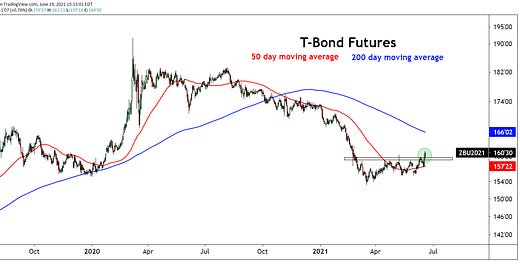What Are Bonds Telling Us?
It’s been a weird 1H for bond investors. The US 10yr bond yield started the year at 91 bps. Starting yields and forward returns have a very high correlation. No one came into 2021 thinking we’d see an above average year from long bonds (we likely will not, TLT is -7% YTD). Many portfolio managers and financial advisors shifted client portfolios away from duration risk and became willing to accept more credit risk. Short duration and alternative funds were the topic of conversation the past few quarters. Painted as the solution to poor expected bond returns and low yields. But has the landscape changed? Is now an opportune time to add duration risk - even as the long bond yield rests just above 2%?
*Enter the inflation/deflation narrative*
Long story short, those who believe inflation is here to stay and will likely intensify, are betting on higher interest rates and bond price depreciation. Those who believe inflation will soon peak are mostly betting on a flattening of the yield curve by way of long-term rates falling faster than short-term rates i.e. bull flattener. In the intermediate term, this will boost stocks and aid longer dated bonds.
So what do we make of all of this. Well, for the sake of simplicity let’s call the inflation non-believers, the deflationists. They are likely bond bulls, and have not yet given into the cyclical rotation in equities that we’ve seen over the past 6 months i.e. flows moving away from tech and growth and into deep value, materials, financials etc. The deflationists may even think that any attempt to normalize rates is futile. The old saying of, “you can’t turn a pickle back into a cucumber” comes to mind.
The inflationists on the other hand, have bought into this cyclical rotation and expect interest rates to rise in order to counter inflation. They are likely overweight financials, and more cyclically tied value stocks. They believe normalization is the only path forward and are positioned for just that.
Now that we have that cleared up, what are the charts saying? Well T-bonds made new multi-month highs this week. However, are still trading below their 200 day moving average.
After a monstrous run up, the US 10yr minus 2yr interest rate spread is trading below its 50 day moving average.
As benchmark yields form new multi-month lows, the US 2yr bond yield is forming a new 52-week high. I’d say this is potential evidence of a flattening scenario playing out over the next 12 months. Your guess is as good as mine on whether or not this flattening is bearish or bullish.
Short-term rates are moving higher, yet the long bond yield is selling off? It’s known that in inflationary environments, stocks and bonds have a higher than average positive correlation i.e. rates up, bonds down, stocks down. But if the deflationists are right, and we see deflationary forces trump inflationary forces, a negative correlation between stocks and bonds is likely to be introduced. If we’re seeing rates fall and bond prices rise, it is likely we will see selling pressure be put on stocks. In the short-term this scenario is good for both stocks and bonds, but the long-term view spells trouble for stocks.
I think David Cox, CMT, CFA puts it best in the below tweet. The Growth vs. Value debate has taken over headlines, following months of inflation talk and wild CPI and PPI numbers. But the real question here is outside of the equity sandbox. It’s not Growth vs. Value, it’s really Stocks vs. Bonds. Long bonds can act as a great diversifier and downside protection especially in deflationary environments i.e. stocks down, bonds up. Is your portfolio positioned to benefit from this?
In my opinion, it is far too early to take either side of this argument. However, if you haven’t begun to consider adding duration risk, I think it’s time to take a close look. What does this mean for your portfolio? What are the options? Are my stocks too tilted toward value and don’t contain enough quality growth? These are the questions I’ve asked myself over the past few weeks.
That’s enough out of me.
SM






